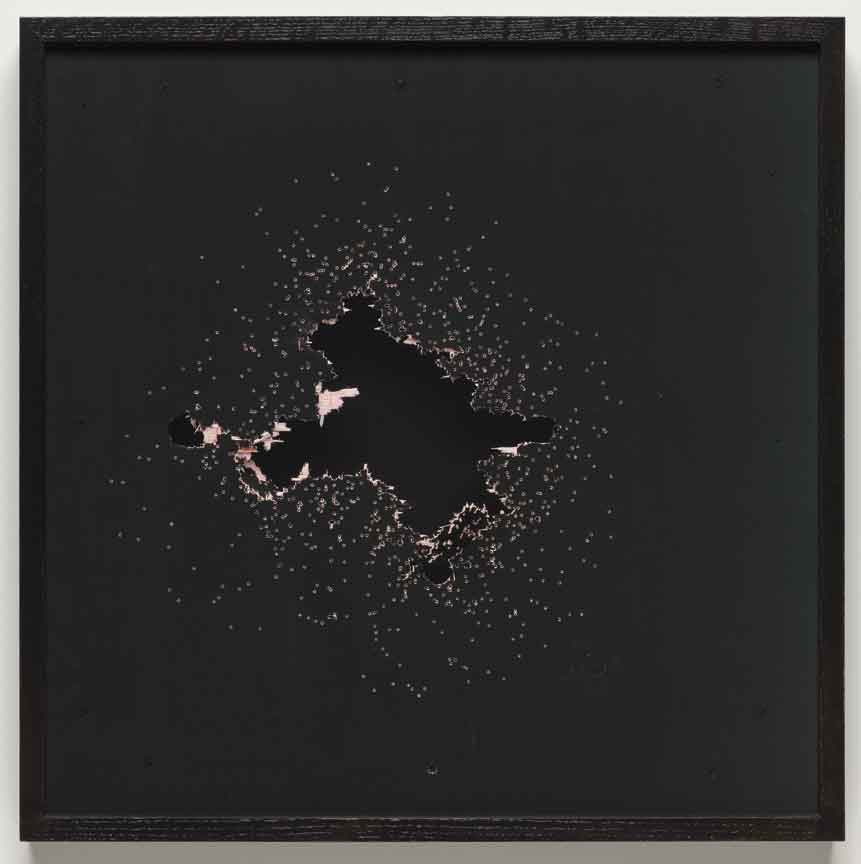« Reviews
The Living Years: Art After 1989
Walker Art Center - Minneapolis
Curated by Siri Engberg and Clara Kim
A Curious Dispassion
By Christina Schmid
Curated by Siri Engberg and Clara Kim, “The Living Years: Art After 1989″ presents a selection of works from the Walker Art Center’s collection. The explicit purpose of the exhibit is twofold: to engage art of the past two decades, a period marked by political upheaval and a curious mix of resilient and emerging cultural predicaments, and to showcase the Walker’s collection practices. From Glenn Ligon and Lorna Simpson to Kara Walker and Ellen Gallagher, African American identity politics feature prominently in a show that, as if ironically, is mostly black and white. Appropriation à la Sherrie Levine gives way to Andrea Bowers’ drawings that painstakingly replicate type-written letters. Krysztof Wodiczko’s politically astute public light projections, displayed here on discreetly placed light boxes, segue to Haegue Yang’s meditations on privacy and transparency in the digital age.

Chris Larson, Blast, 2009, digital print, 25” x 25”. Gift of Marjorie and Irving Weiser, 2009. Courtesy Walker Art Center.
“The Living Years” assembles an art of urgency. Yet there is something disconcerting about seeing this gritty, political work made utterly palatable in the Walker’s white-walled palace. The show is very elegant in thoughtful black and white, with occasional, meaningful dabs of color: Walid Raad’s photographs of Beirut’s bombed architecture, overlaid with the color-coding associated with different types of cartridges and shells, stands out as a case in point. Gleams of metal and foil, as in Thomas Hirschhorn’s giant Necklace CNN (2002) or the gold embroidery-”Us” and “Them”-on Gary Simmons’ white cotton robes (1991), contrast with the heartfelt authenticity of wood and wax elsewhere. But “The Living Years” casts the work in an oddly sterile light, severed from the messy politics and struggles that gave rise to it. Even Mike Kelley’s Four Part Butter-Scene N’Ganga (1997), featuring four galvanized washtubs filled with fake fruit, accompanied by a grunt-and-gasp soundtrack gleaned from Bertolucci’s Last Tango in Paris, appears less abrasive than tame when contextualized next to a spotless quasi-minimalist Tiravanija installation. “The Living Years” courts the perceived risk of representing historical narratives that are still very much in the process of unfolding, but reduces them to smart, at times formally compelling episodes, to curiously lifeless stories without barbs.
Chris Larson’s Blast (2009) provides the perfect metaphor for “The Living Years” as a whole: a smooth, mostly monochrome digital print frustrates the desire to see the textured traces of a bullet’s impact up close. The black surface glosses over the grit, dents, and splinters to present a perfect two-dimensional image of the blast. While “The Living Years” makes every effort to touch on salient issues, such as women’s rights, the Dakota-Minnesota conflict of 1862, the presence of war and the plight of veterans, they remain in a world apart, carefully cordoned off. The dispassion is deeply at odds with the work on display. Katharina Fritsch’s Pudel (1995) invites another analogy: “The Living Years” is a poodle of a show, trimmed and coiffed in all the right places, yet somehow missing the complicated character of a genuine mutt, as eager to misbehave and ruffle some feathers as the art of the past two decades has been.
(September 6, 2012 - January 4, 2015)
Filed Under: Reviews



































Leave a Reply
You must be logged in to post a comment.